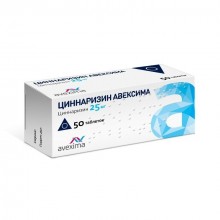



The tool is prescribed for such diseases:
Active ingredient: 25 mg cinnarizine
Additional ingredients:
Cinnarizine is marketed under different brands and generic names, and comes in different dosage forms:
| Brand name | Manufacturer | Country | Dosage form |
|---|---|---|---|
| Cinnarizine | Anzhero-Sudzhensky HFZ | Russia | pills |
| Cinnarizine | PFK Obnovlenie | Russia | pills |
| Cinnarizine | Pharma AD | Bulgaria | pills |
| Stugeron | Gedeon Richter | Hungary | pills |
| Cinnarizine | Sopharma | Bulgaria | pills |
No customer reviews for the moment.
Inside, after eating.
In case of insufficiency of cerebral circulation - 25 mg 3 times / day.
In case of violation of the peripheral circulation - 50-75 mg 3 times / day.
When vestibular disorders - 25 mg 3 times / day.
The maximum recommended dose should not exceed 225 mg (9 pills) per day. The course of treatment from several weeks to several months.
In case of kinetosis (road sickness): for adults - 25 mg per half hour before the road (if necessary, 25 mg reapptake after 6 hours), for children from 5 years old - 1/2 dose recommended for adults.
With high sensitivity to the drug, treatment starts from 1/2. dose, increasing it gradually.
Nervous system disorders: drowsiness, fatigue, headache, extrapyramidal disorders (tremor of the limbs and increased muscle tone, hypokinesia), depression.
On the part of the digestive system: dry mouth, pain in the epigastric region, dyspepsia, cholestatic jaundice.
On the part of the skin: sweating, the development of lupus-like syndrome, lichen planus (extremely rare), skin rash.
Other: allergic reactions, weight gain.
- hypersensitivity;
- pregnancy;
- lactation period;
- children's age up to 5 years.
With caution in Parkinson's disease.
Strengthens the inhibitory effect on the central nervous system of alcohol, sedatives, tricyclic antidepressants. Due to the presence of an antihistamine effect, cinnarizine can affect the result of the athletes' anti-doping control (false positive result), and can also neutralize positive reactions during skin diagnostic tests (4 days before the study, treatment should be canceled).
Patients with Parkinson’s disease are prescribed only when the benefits of treatment with cinnarizine exceed the possible worsening of the course of the underlying disease.
At the beginning of treatment can cause drowsiness, so taking alcohol and the simultaneous use of CNS depressants requires caution.
In connection with the antihistamine effect, cinnarizine should be discontinued 4 days before the allergic skin test. Cinnarizine can affect the result in athletes' anti-doping control (false positive).
In case of lactose intolerance, please note that 1 tablet contains 175 mg of lactose.
Influence on ability to steer the car and other working mechanisms
Drowsiness may develop, especially at the beginning of treatment, so care should be taken when driving vehicles and engaging in other potentially hazardous activities that require increased concentration and psychomotor speed. With prolonged use, it is recommended to conduct a laboratory test of the liver, kidney, and peripheral blood.
Symptoms: increased severity of side effects, decreased blood pressure, vomiting, coma.
Treatment: there is no specific antidote, gastric lavage, taking activated charcoal, symptomatic therapy.